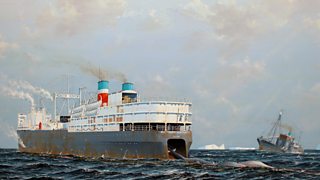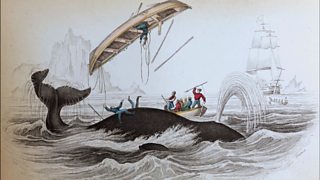A glimpse into the world of British whaling in the 1950s
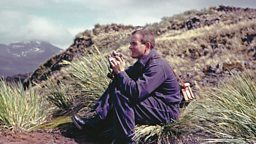
This is me with my camera. I bought it the first time I went down to South Georgia — to work as an electrician for , Britain's biggest whaling company. I was employed first at on from 1954 and, later, on floating factory ships until 1961.
The photo was taken by my late friend Geoff Smethurst; we did a lot of photography together. We'd pop out at lunchtime to take photos, and Geoff had a little darkroom in the radio room where he worked.
From the start, I took photos to show friends & family back home in Dundee. Looking back, the Kodachrome images are an amazing record of the whaling industry at that time. I occasionally exhibit my photos and use the proceeds to raise funds for .
Laid-up Catchers at Leith Harbour, 1950s

This was taken one lunchtime when I climbed up Coronda Peak next to Leith Harbour. The large ship is Southern Opal – she was a transport ship that took whalers and supplies between the UK and South Georgia.
The Opal would lie there for 6 months between the beginning and end of the season. The laid-up whale catchers in the foreground were ones that were surplus to the company’s quota for that season.
A bull elephant seal
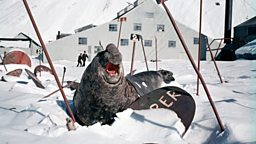
I had stayed down in South Georgia to work through the winter, and I took a ride down to the neighbouring station of Stromness. This was used by the Salvesen company as a ship repair base. These markers were so that they could find the ship’s propellers in the snow. This bull elephant seal was probably one of the early arrivals in spring, waiting for the females to arrive.
He obviously thought I was getting a bit too close to take my picture!
Ski jumping at Grytviken

This must have been the 1957 winter. There was an annual ski competition between all the whaling stations. I had learnt to ski but I took my hat off to the guys who were brave enough to try ski jumping.
The flags are the Norwegian flag, the Union Jack, and the Argentinian flag: because Grytviken whaling station was operated by an Argentine company, though almost all the managers and whalers were Norwegian.
The Whaling Station laboratory

My friend George Bennett was the chemist at Leith Harbour. I took that picture because I wired that place up and installed the lighting. The laboratory was for quality control. The quality of the whale oil was tested and graded. Grade 1 oil was the best and would be used for margarine – that would have to be kept in certain tanks away from the lower-grade oil.
Whale Ahoy!
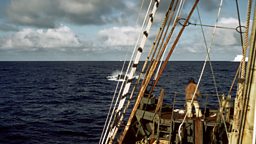
I went on a five day trip on one of the whale catchers, but this photo was actually taken by a friend of mine. I gave him a film at the start of a season and he gave it back to me with pictures on it at the end.
They’re on the chase in this photo. The whale would sometimes zig-zag but the catcher would zig-zag also to give the gunner a chance of a flank shot. The catchers had a spotter up in the barrel and ASDIC (sonar) so they could follow the whale even if it dived below the surface. The British lads, who were on the catchers had to be able to understand Norwegian because the crews were approximately 80% Norwegian, and orders and instructions would be flying around when they were chasing a whale.
The factory ship 'Southern Harvester'
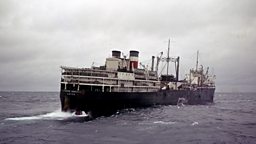
Salvesen’s had two factory ships which were like a floating whaling station, but far more cramped – they could fully process the whales, and house hundreds of whalers and technicians like me. I worked on both the Southern Harvester (in 1958/59) and the Southern Venturer (1959/60).
The second season on the Venturer was very poor and we could all see that the writing was probably on the wall.
Continue your journey into the history of British whaling
-
![]()
Take a look at George Cumming's paintings of the ships he came across during his time in the whaling industry.
-
![]()
Adam Nicolson examines how whale oil and whale bone were used in lighting, corsets, soap and umbrellas and finds out about the treacherous conditions many hunters faced.
